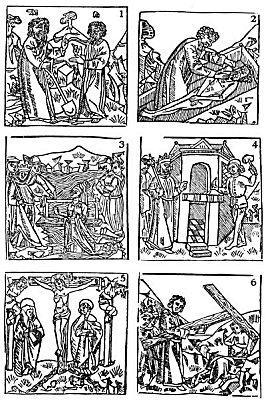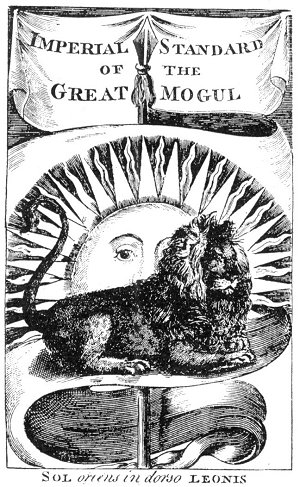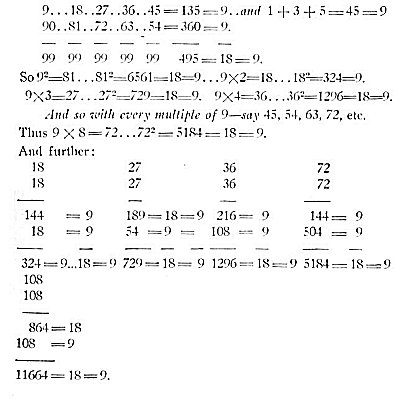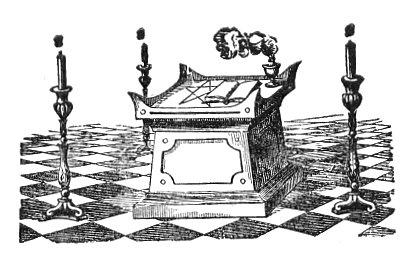earth and fire. The Ceylonese demon called Dewel is a stout smiling female figure with a white Elizabethan frill around the neck and a red jacket.
As Dr. Warton justly observes: “There is no character more strictly Oriental than the dragons of romance and fiction; they are intermixed with every tradition of early date and of themselves confer a species of illustrative evidence of origin.” In no writings are these characters more marked, than in the details of Buddhism; these record particulars of the Nagas, or kingly snakes, inhabiting the cavities under the earth, corresponding with the abodes of Tiresias and the Greek seers, a region of mystery and darkness, wherein revolves much of the system of divination and oracular response, connected with inflation, or a sort of possession, designating the spirit of Python himself, the dragon-serpent slain by Apollo. But the Buddhists no more believe in the devil of the Christian system — that is, an entity as distinct from humanity as the Deity itself — than the Hindus. Buddhists teach that there are inferior gods who have been men either on this or another planet, but still who were men. They believe in the Nagas, who had been sorcerers on earth, bad people, and who give the power to other bad and yet living men to blight all the fruit they look upon, and even human lives. When a Cinghalese has the reputation that if he looks on a tree or on a person both will wither and die, he is said to have the Naga-Raja, or king-serpent on him. The whole endless catalogue of bad spirits are not devils in the sense the Christian clergy wants us to understand, but merely spiritually incarnated sins, crimes, and human thoughts, if we may so express it. The blue, green, yellow, and purple god-demons, like the inferior gods of Jugandere, are more of the kind of presiding genii, and many are as good and beneficient as the Nat deities themselves, although the Nats reckon in their numbers, giants, evil genii, and the like which inhabit the desert of Mount Jugandere.
The true doctrine of Buddha says that the demons, when nature produced the sun, moon, and stars, were human beings, but, on account of their sins, they fell from the state of felicity. If they commit greater sins, they suffer greater punishments, and condemned men are reckoned by them among the devils; while, on the contrary, demons who die (elemental spirits) and are born or incarnated as men, and commit no more sin, can arrive at the state of celestial felicity. Which is a demonstration, remarks Edward Upham, in his History and Doctrine of Buddhism, that all beings, divine as well as human, are subject to the laws of transmigration, which are operative on all, according to a scale of moral deeds. This faith then, is a complete test of a code of moral enactments and motives, applied to the regulation and government of man,
Page 449
an experiment, he adds, “which renders the study of Buddhism an important and curious subject for the philosopher.”
The Hindus believe, as firmly as the Servians or Hungarians, in vampires. Furthermore, their doctrine is that of Pierart, the famous French spiritist and mesmerizer, whose school flourished some dozen years ago. “The fact of a spectre returning to suck human blood,” says this Doctor, “is not so inexplicable as it seems, and here we appeal to the spiritualists who admit the phenomenon of bicorporeity or soul-duplication. The hands which we have pressed . . . these ‘materialized’ limbs, so palpable . . . prove clearly how much is possible for astral spectres under favorable conditions.”
The honorable physician expresses the theory of the kabalists. The Shadim are the lowest of the spiritual orders. Maimonides, who tells us that his countrymen were obliged to maintain an intimate intercourse with their departed ones, describes the feast of blood they held on such occasions. They dug a hole, and fresh blood was poured in, over which was placed a table; after which the “spirits” came and answered all their questions.
Pierart, whose doctrine was founded on that of the theurgists, exhibits a warm indignation against the superstition of the clergy which requires, whenever a corpse is suspected of vampirism, that a stake should be driven through the heart. So long as the astral form is not entirely liberated from the body there is a liability that it may be forced by magnetic attraction to reenter it. Sometimes it will be only half-way out, when the corpse, which presents the appearance of death, is buried. In such cases the terrified astral soul violently reenters its casket; and then, one of two things happens — either the unhappy victim will writhe in the agonizing torture of suffocation, or, if he had been grossly material, he becomes a vampire. The bicorporeal life begins; and these unfortunate buried cataleptics sustain their miserable lives by having their astral bodies rob the life-blood from living persons. The ethereal form can go wherever it pleases; and so long as it does not break the link which attaches it to the body, it is at liberty to wander about, either visible or invisible, and feed on human victims. “According to all appearance, this ‘spirit’ then transmits through a mysterious and invisible cord of connection, which perhaps, some day may be explained, the results of the suction to the material body which lies inert at the bottom of the tomb, aiding it, in a manner, to perpetuate the state of catalepsy.”

Moe is the founder of GnosticWarrior.com. He is a father, husband, author, martial arts black belt, and an expert in Gnosticism, the occult, and esotericism.





